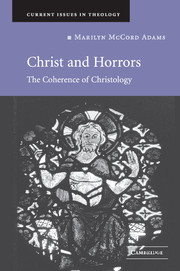Book contents
- Frontmatter
- Contents
- Preface
- 1 Christology as natural theology: methodological issues
- 2 Posing the problems: beginning with Job
- 3 Sharing the horrors: Christ as horror-defeater
- 4 Psychologizing the person: Christ as God-man, psychologically construed
- 5 Recovering the metaphysics: Christ as God-man, metaphysically construed
- 6 Learning the meanings: Christ in the hearts of all people
- 7 Cosmic coherence and the primacy of Christ: Christ, the One in Whom all things hold together
- 8 Resurrection and renewal: Christ the first fruits
- 9 Horrors and holocausts, sacrifices and priests: Christ as priest and victim
- 10 Christ in the sacrament of the altar: Christ in the meantime
- Bibliography
- Index
2 - Posing the problems: beginning with Job
Published online by Cambridge University Press: 03 December 2009
- Frontmatter
- Contents
- Preface
- 1 Christology as natural theology: methodological issues
- 2 Posing the problems: beginning with Job
- 3 Sharing the horrors: Christ as horror-defeater
- 4 Psychologizing the person: Christ as God-man, psychologically construed
- 5 Recovering the metaphysics: Christ as God-man, metaphysically construed
- 6 Learning the meanings: Christ in the hearts of all people
- 7 Cosmic coherence and the primacy of Christ: Christ, the One in Whom all things hold together
- 8 Resurrection and renewal: Christ the first fruits
- 9 Horrors and holocausts, sacrifices and priests: Christ as priest and victim
- 10 Christ in the sacrament of the altar: Christ in the meantime
- Bibliography
- Index
Summary
Rubrics, manifold and shifting
Good theories exhibit elegant simplicity by virtue of having one (type of) explanatory posit do many different jobs and thereby occupy a variety of theoretical roles. In patristic and medieval Latin school theology, God is taken to be the ultimate explainer of both the being and the goodness of everything. Augustine, Anselm, and Aquinas add truth to the list of what needs to be explained; following Aristotle, Aquinas identifies God as the unmoved mover, the first efficient cause of any and every change. In the order of discovery, Christology begins with another set of explananda – with the fact that the human condition generally and Divine–human relations in particular are non-optimal. It attempts to analyze their nature, to trace their source, and to identify their remedy. Christian soteriology (which probes how we are to be saved from what ails us) concludes that God was in Christ exercising the Savior's role.
Overlapping rubrics
Beginning with the Bible, Christian tradition has conceptualized these twin non-optimalities in different, contrasting, and complementary ways. (1) In terms of purity versus defilement: The God of Leviticus declares, “You must be holy as I am holy!” (Leviticus 2:19). But humans are unclean, defiled. Christ is both priest and victim, the one pure sacrifice offered for us once and for all on the cross, that spotless oblation presented daily on that altar eternal in the heavens.
- Type
- Chapter
- Information
- Christ and HorrorsThe Coherence of Christology, pp. 29 - 52Publisher: Cambridge University PressPrint publication year: 2006

